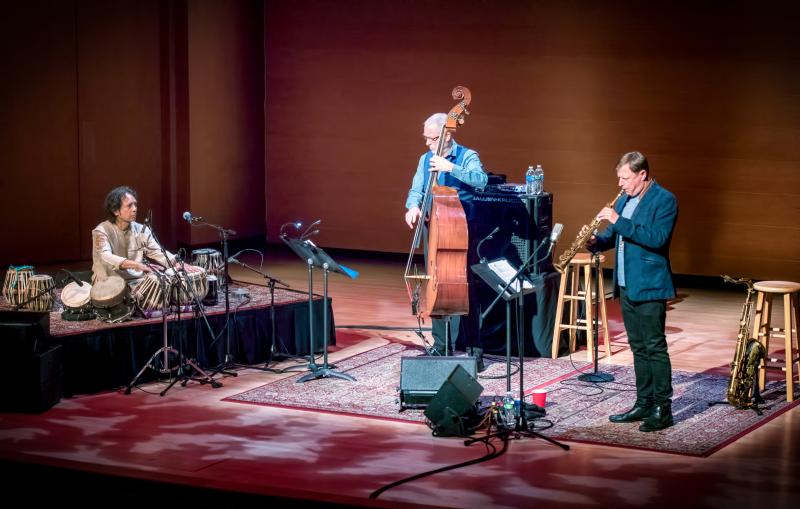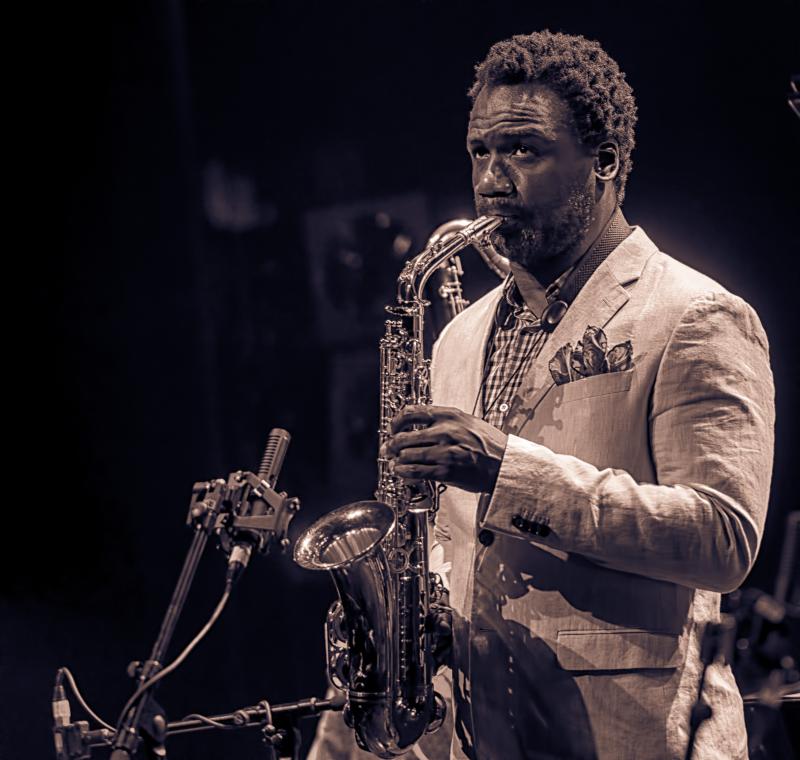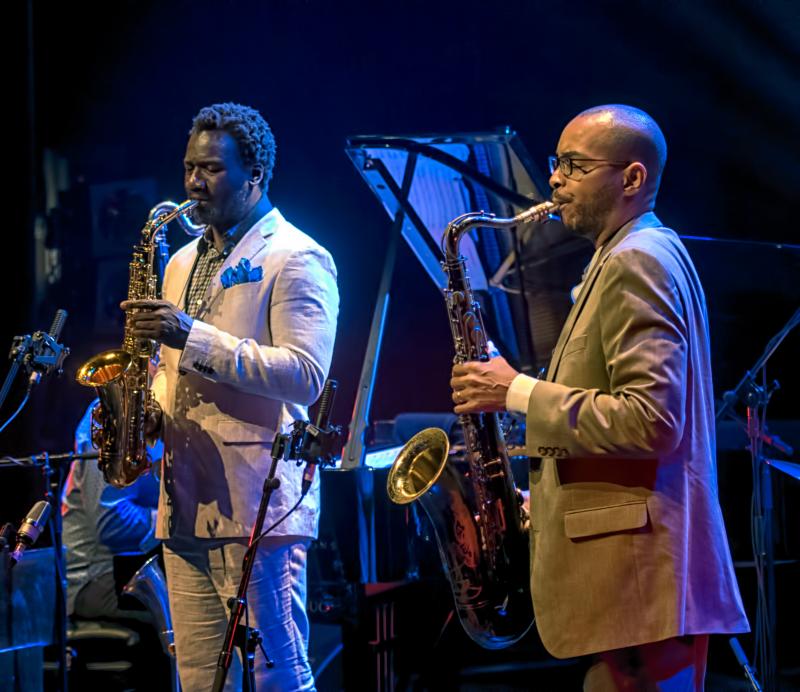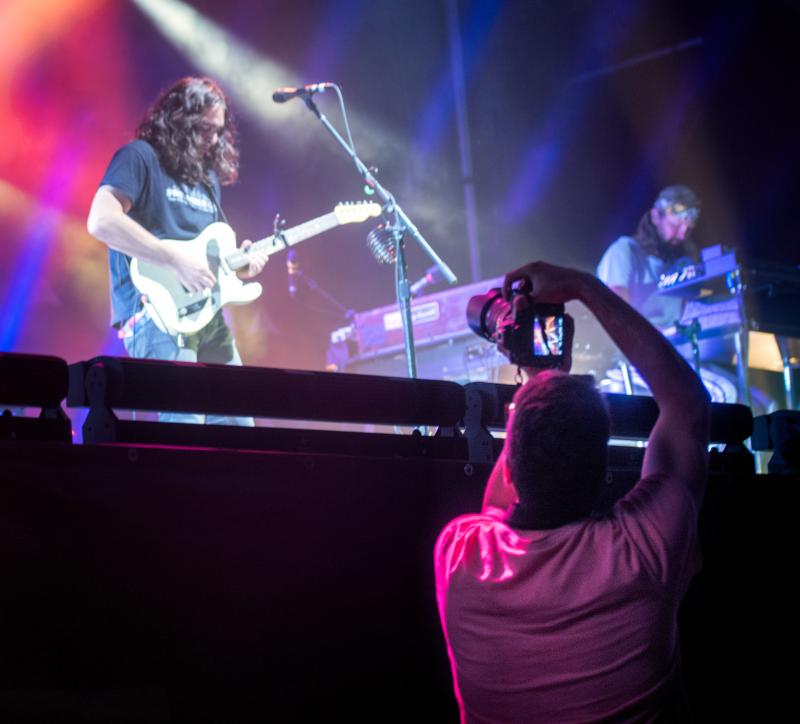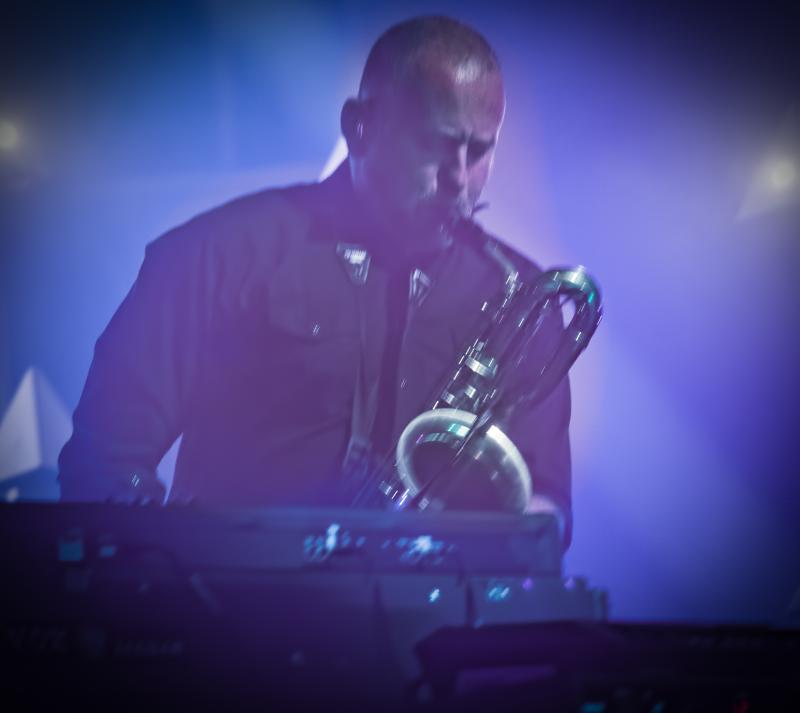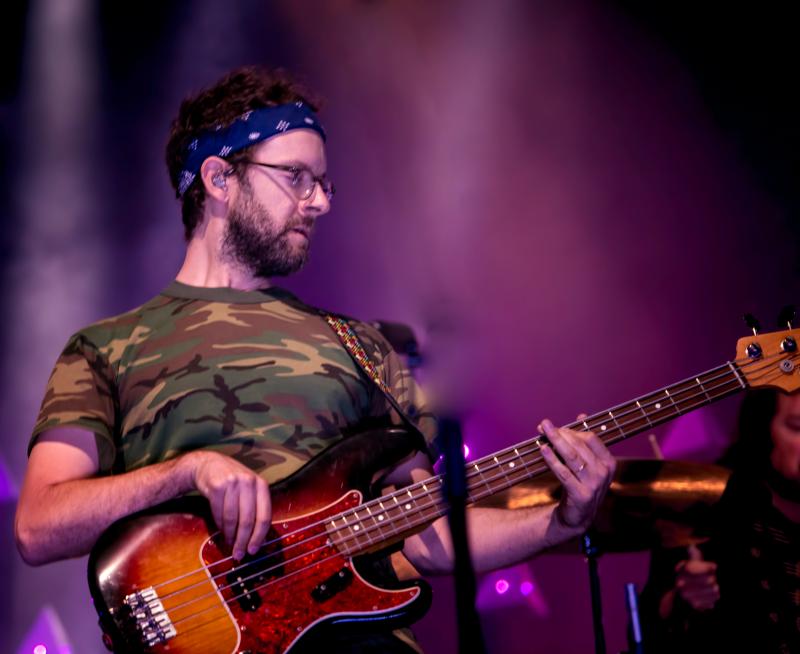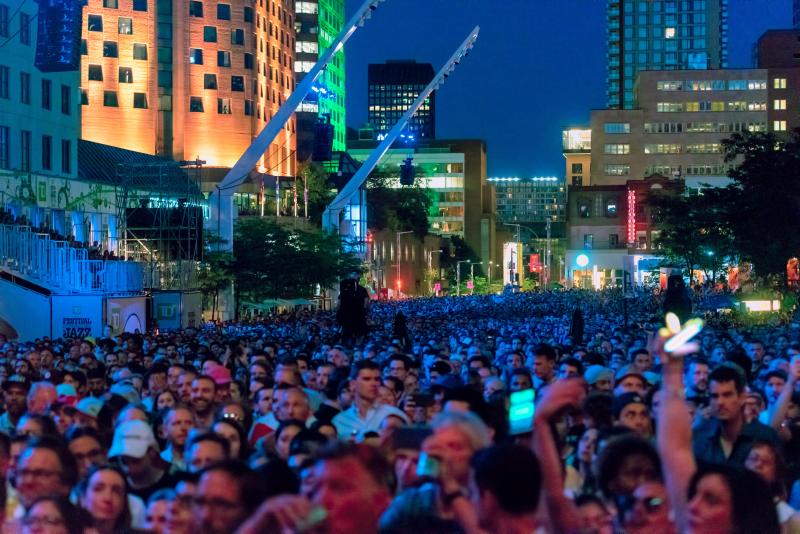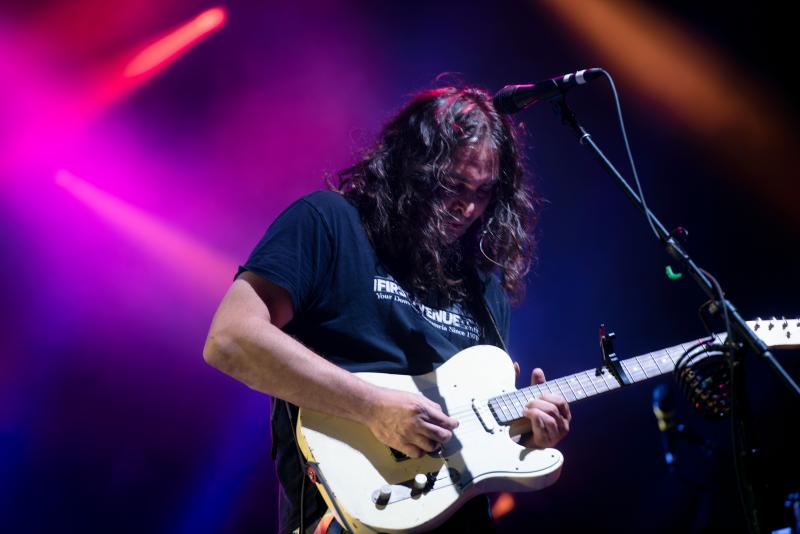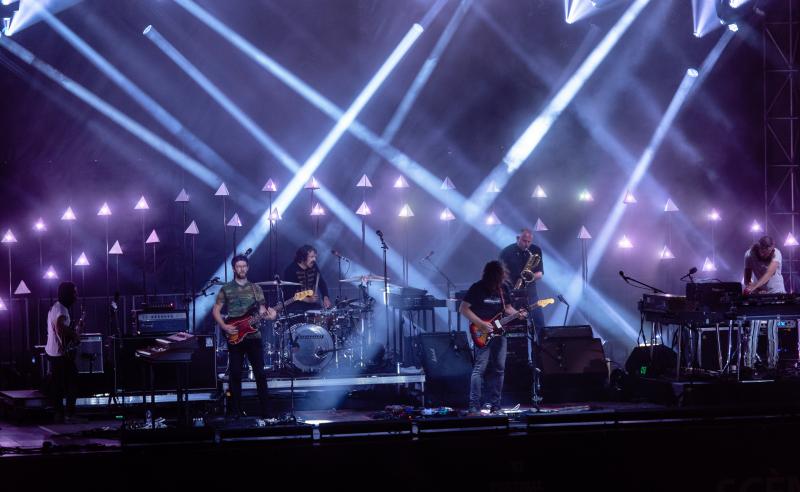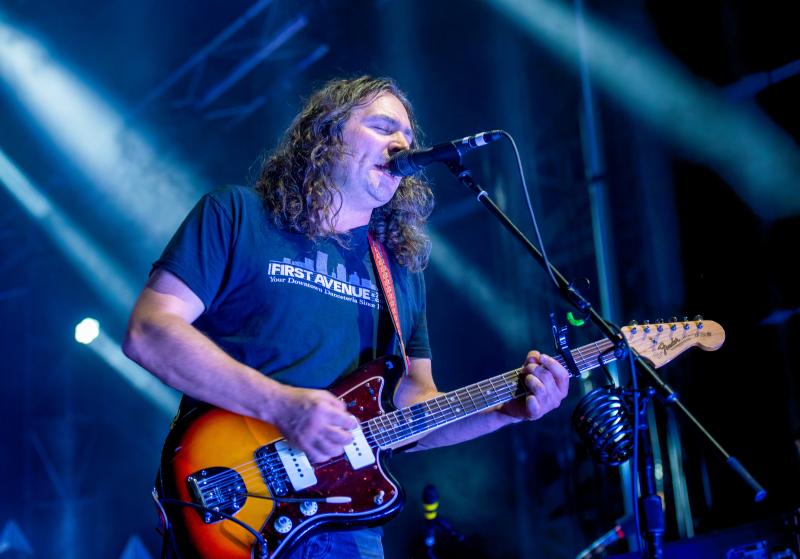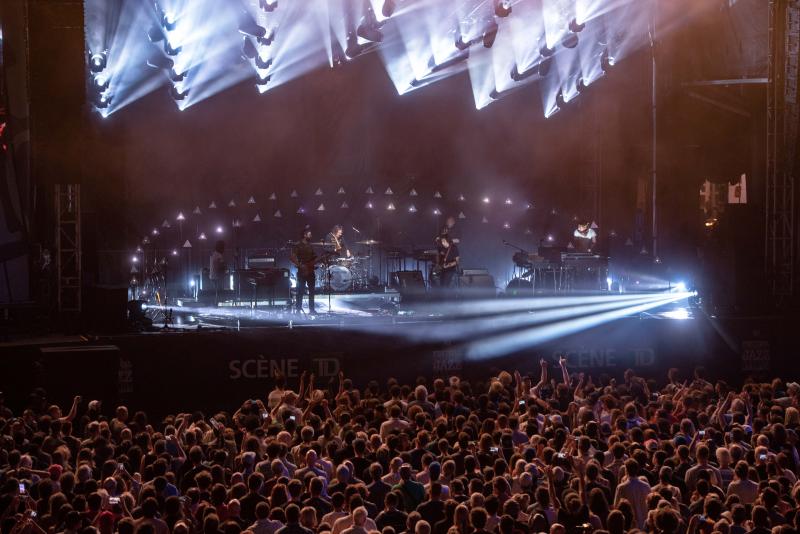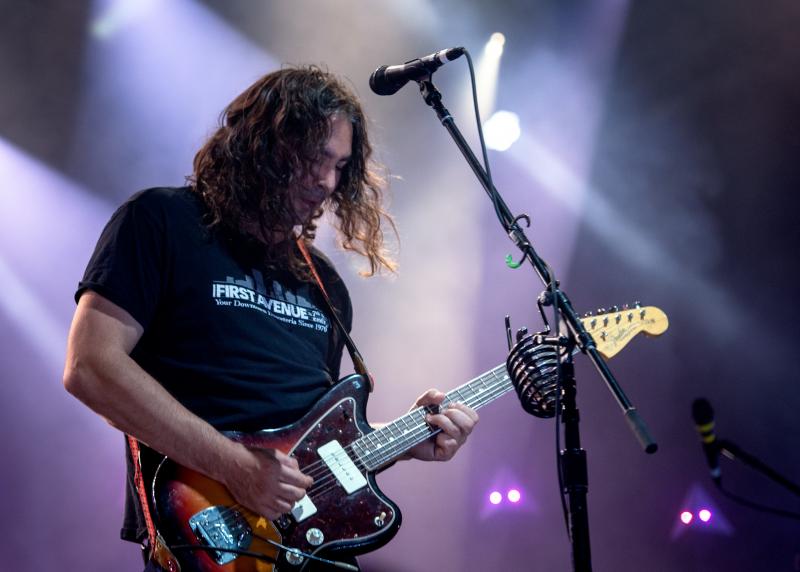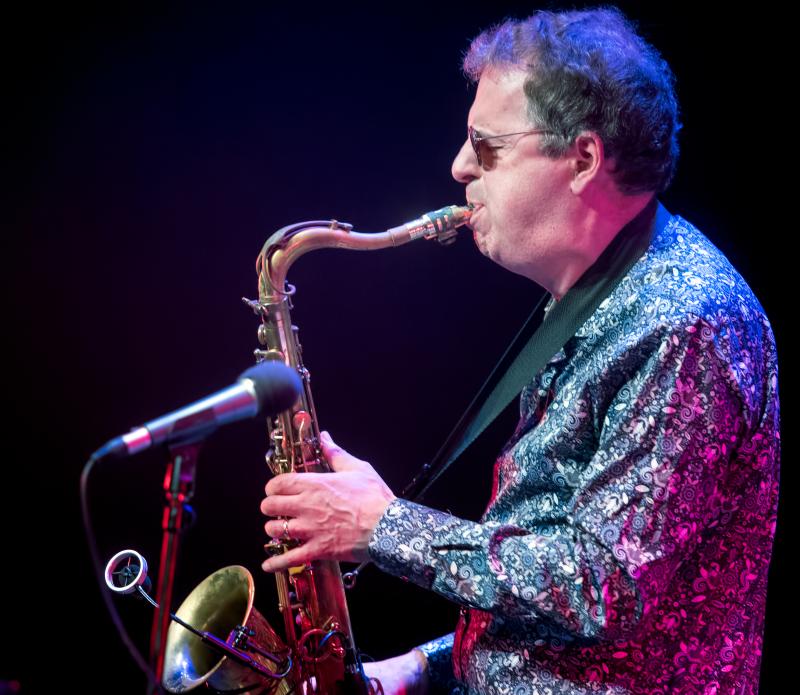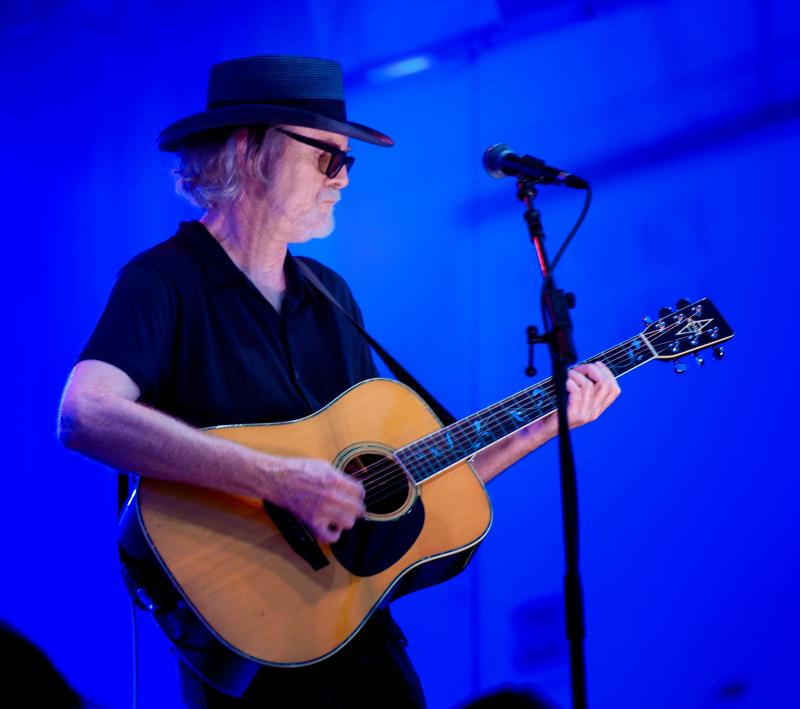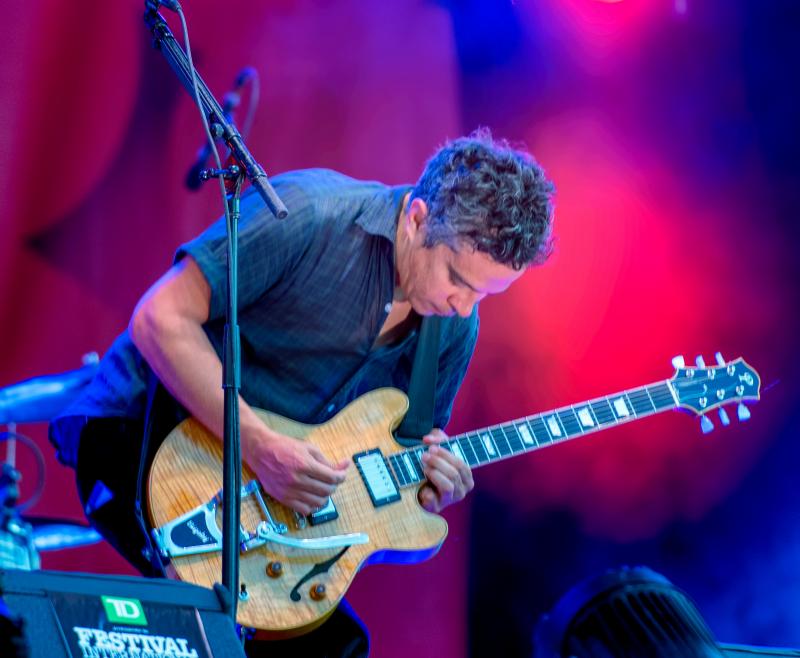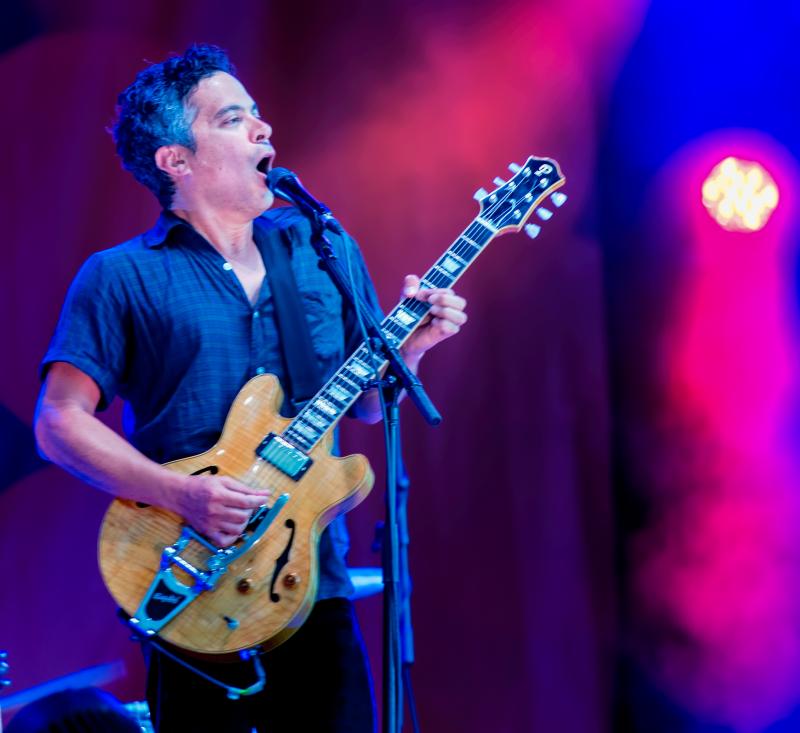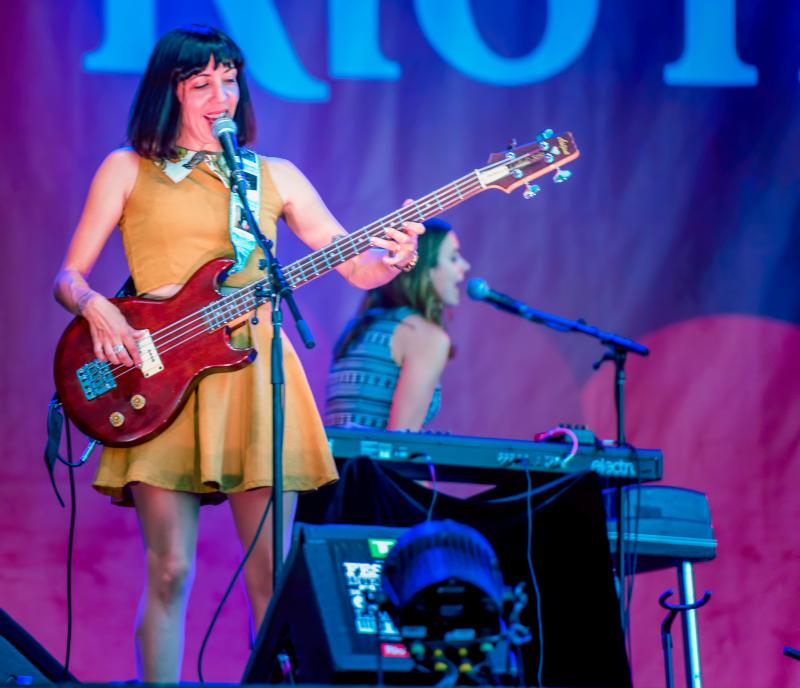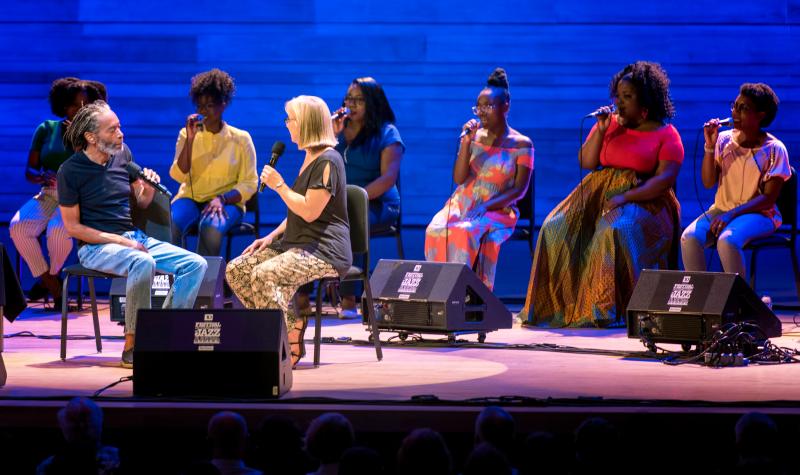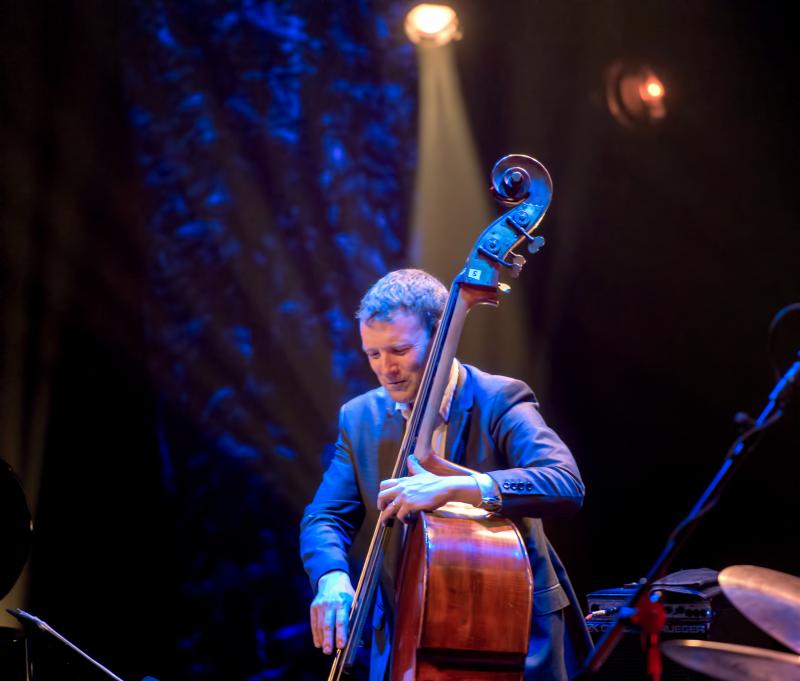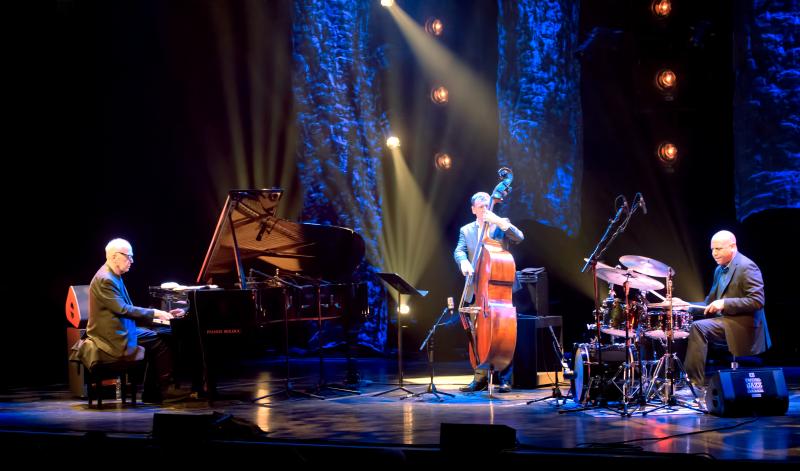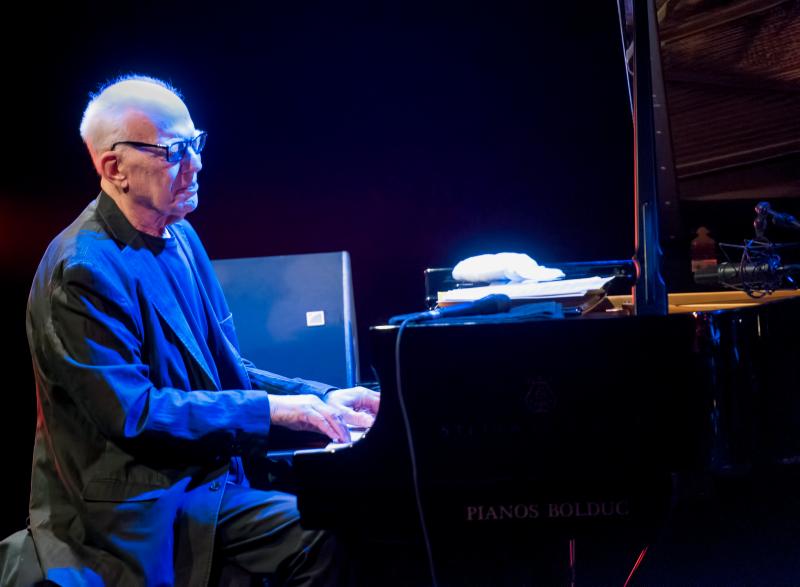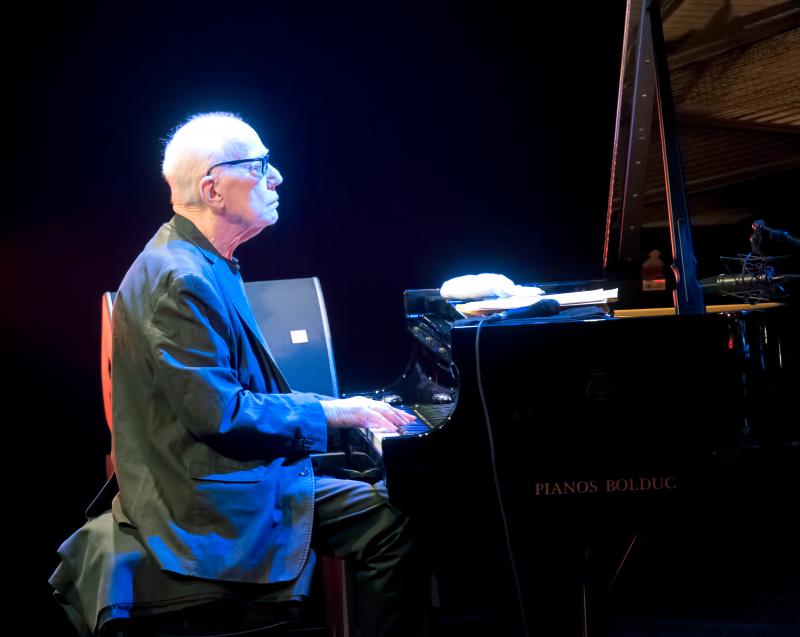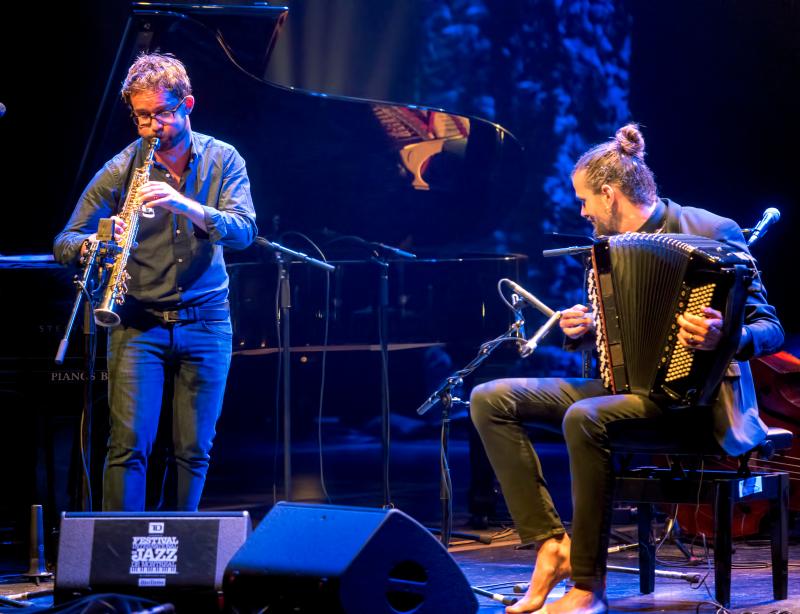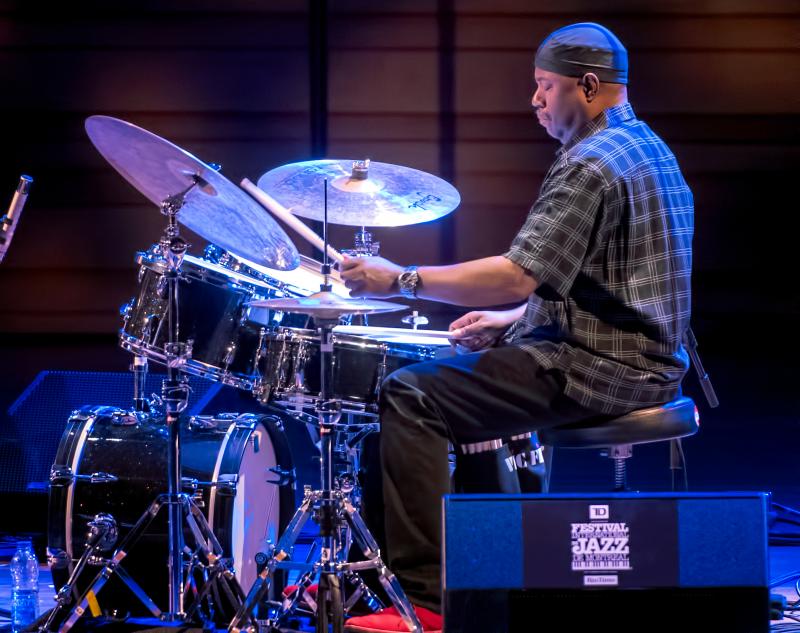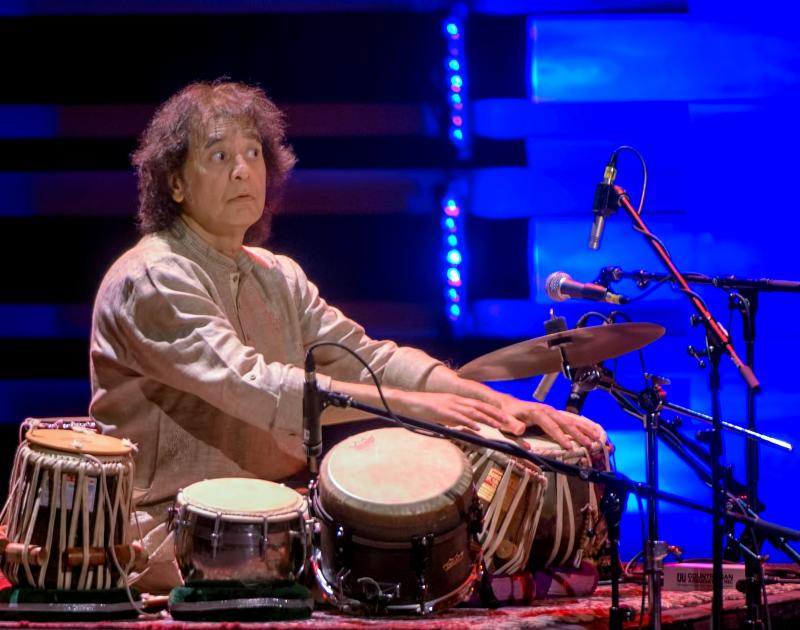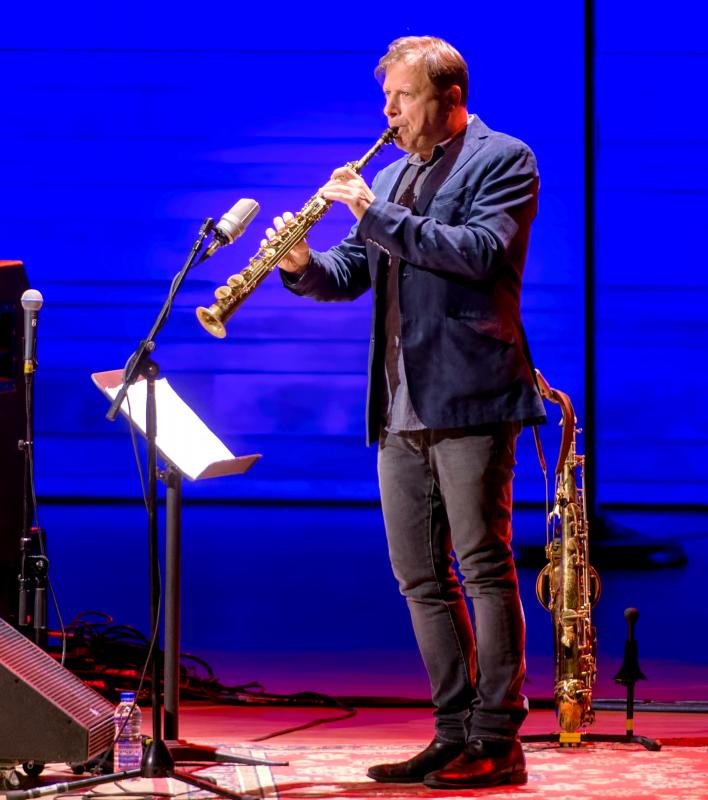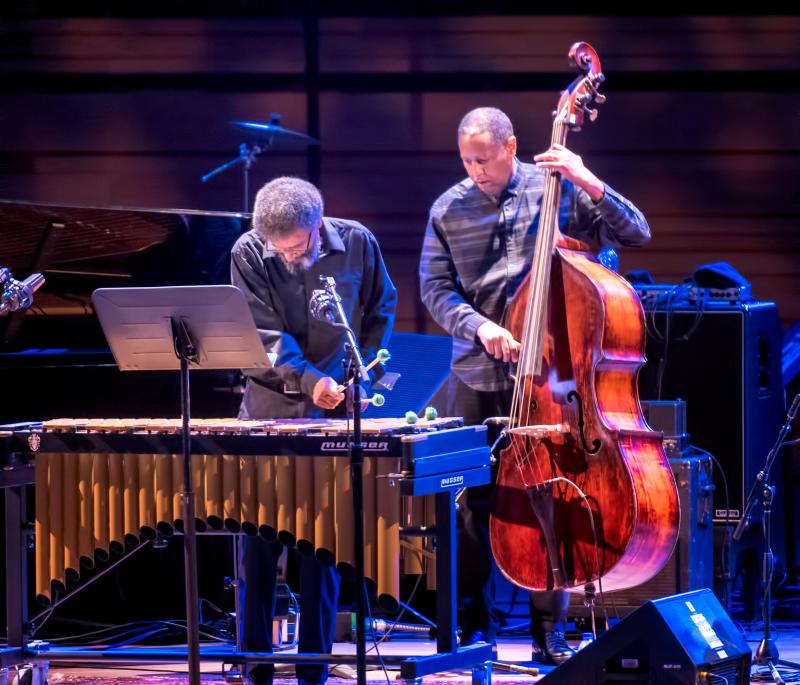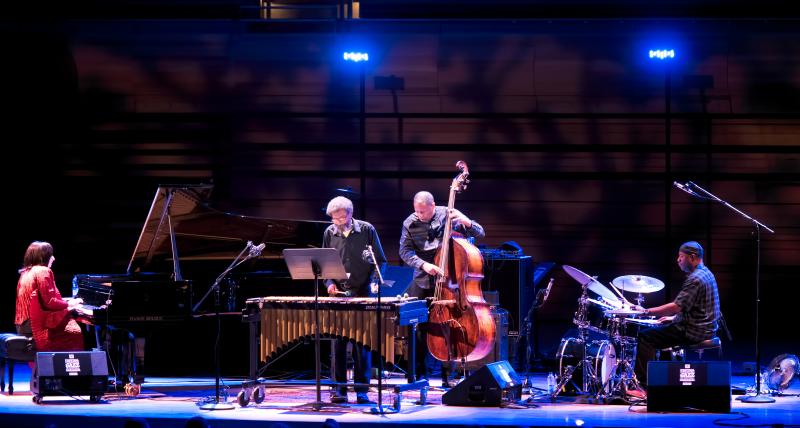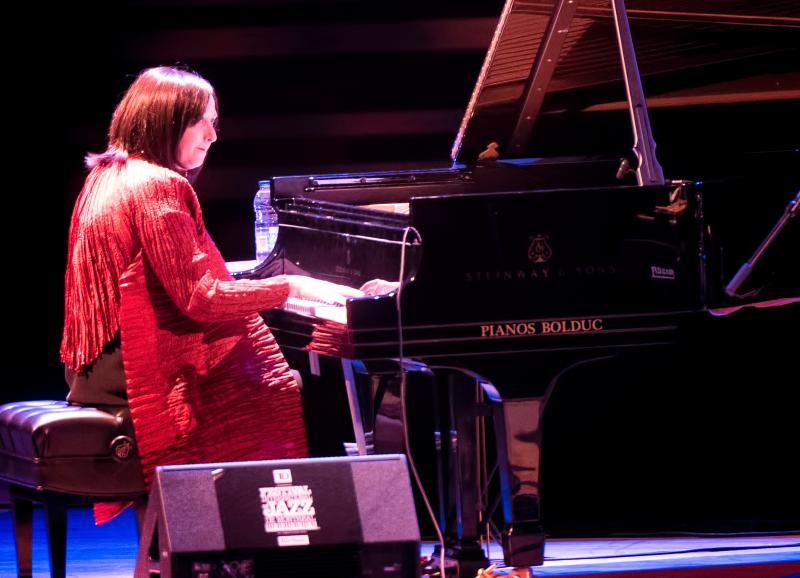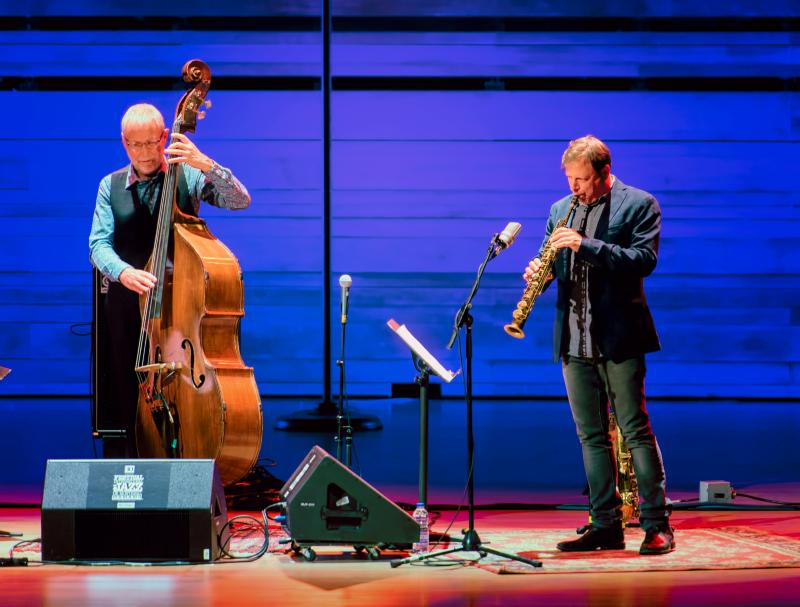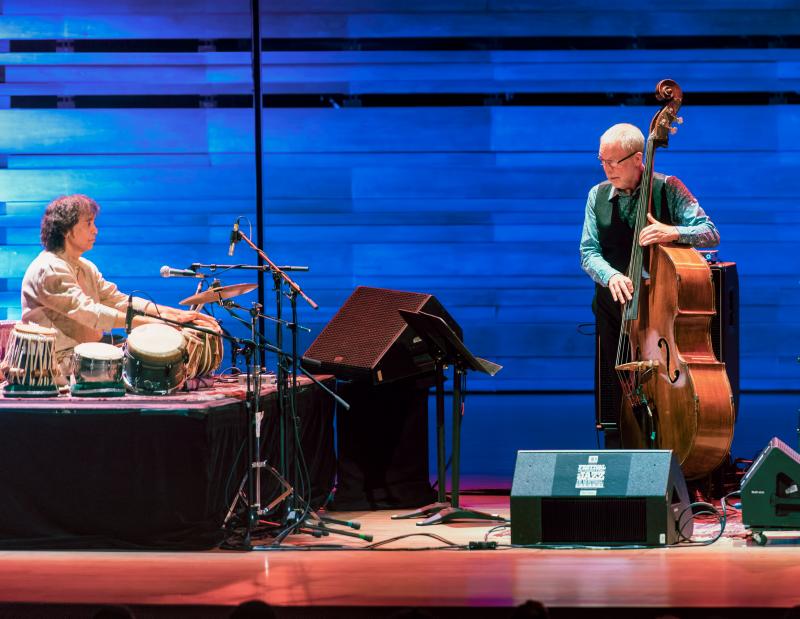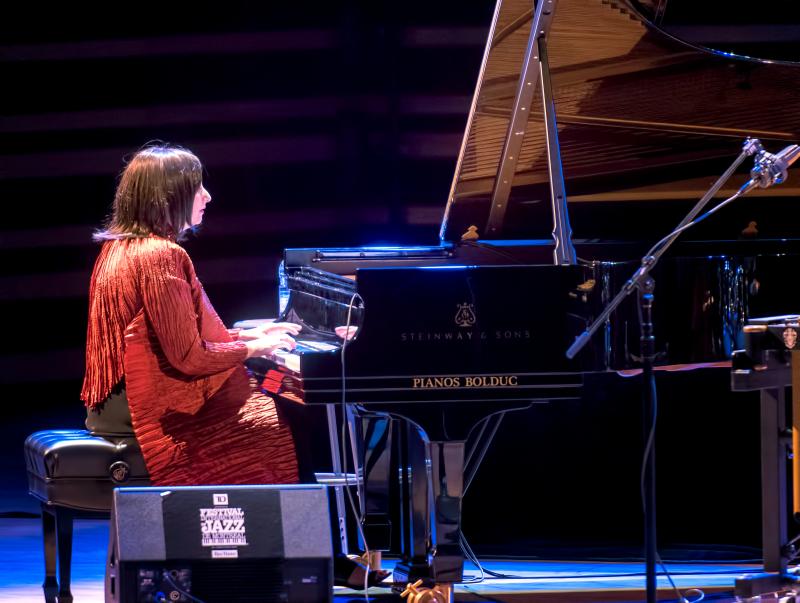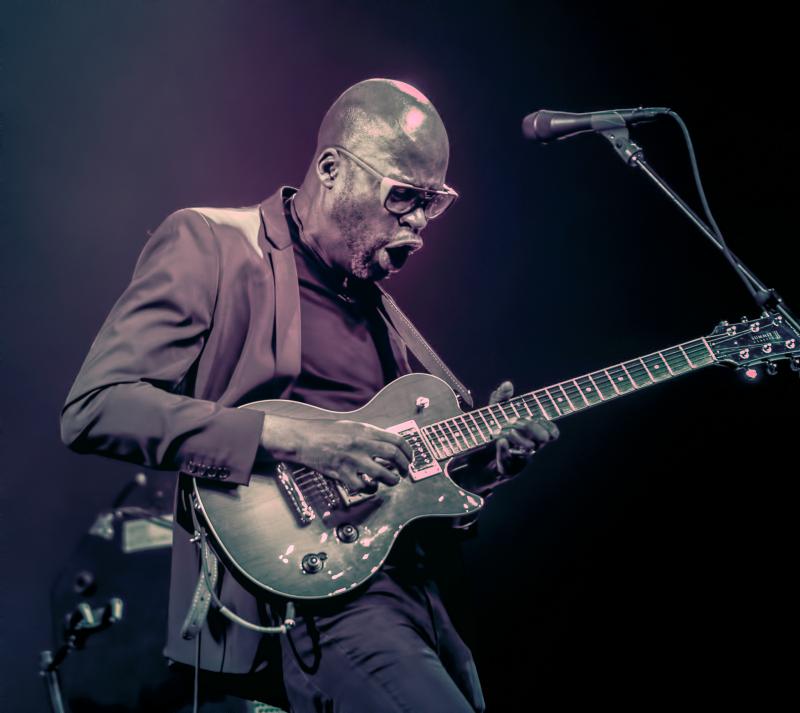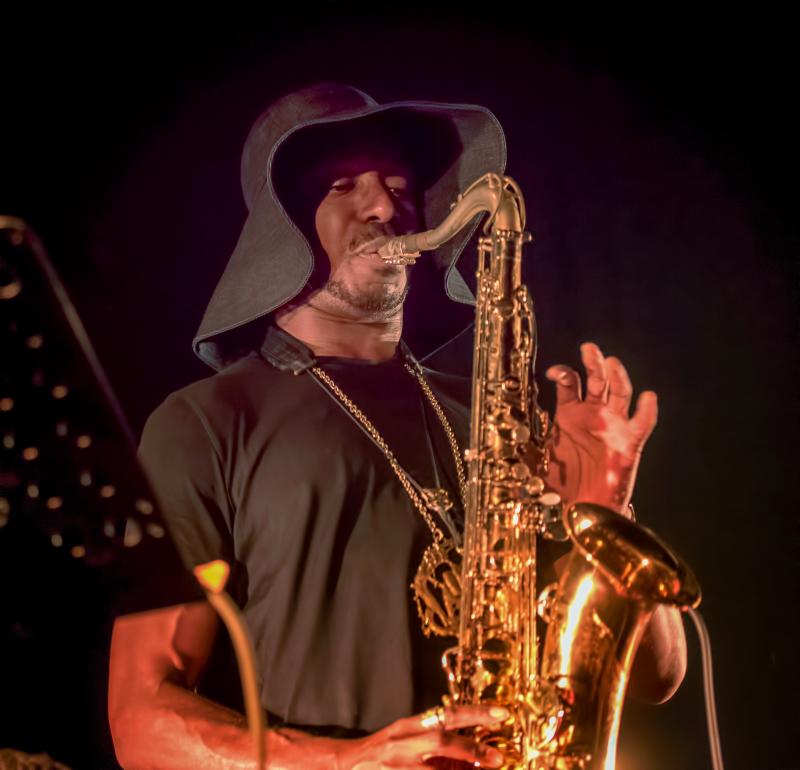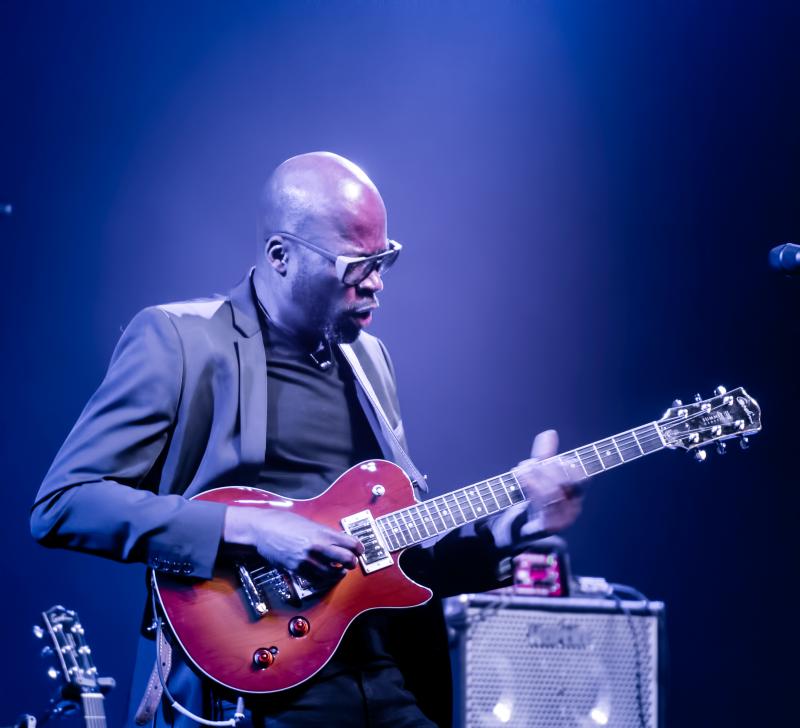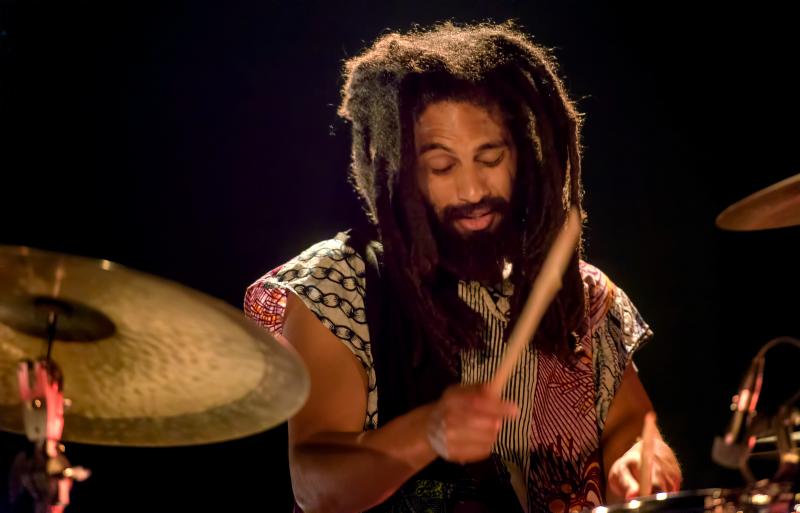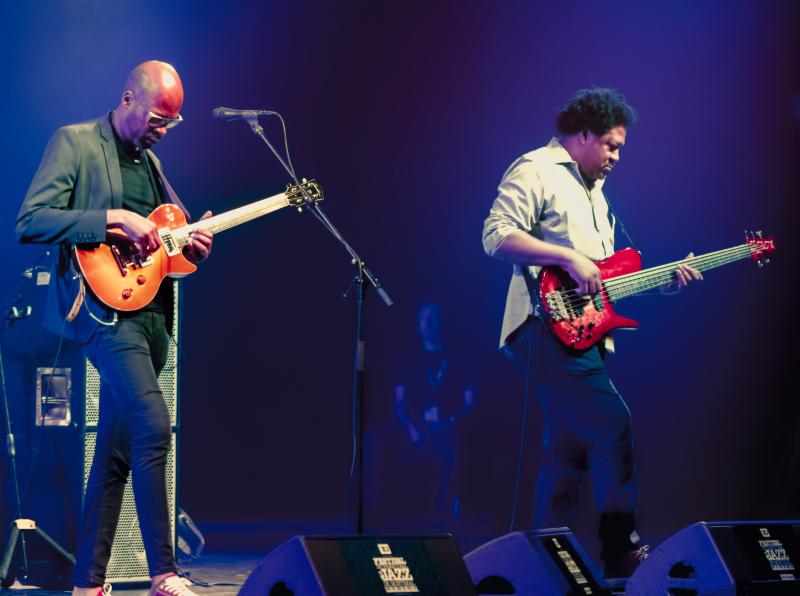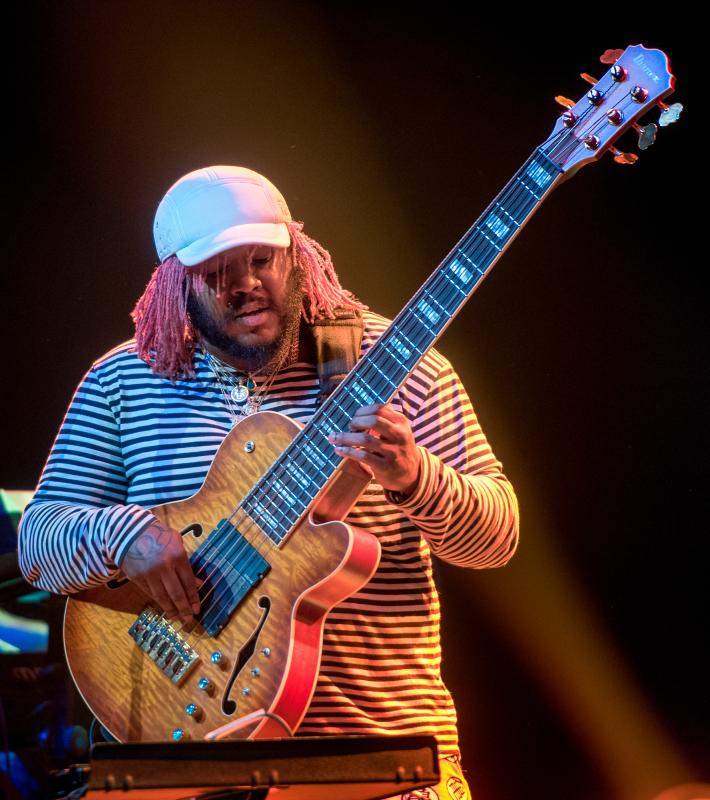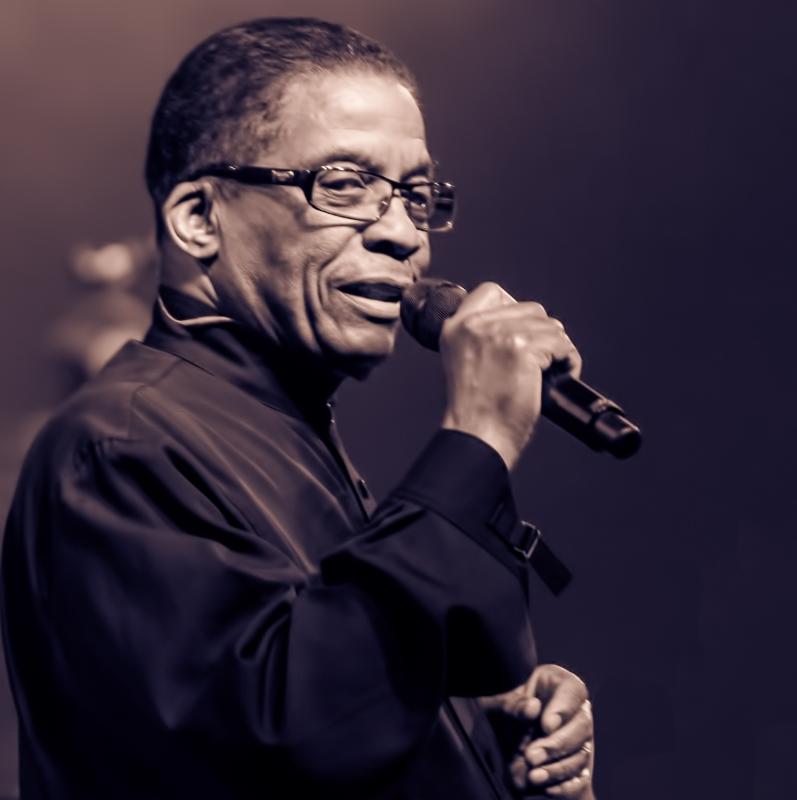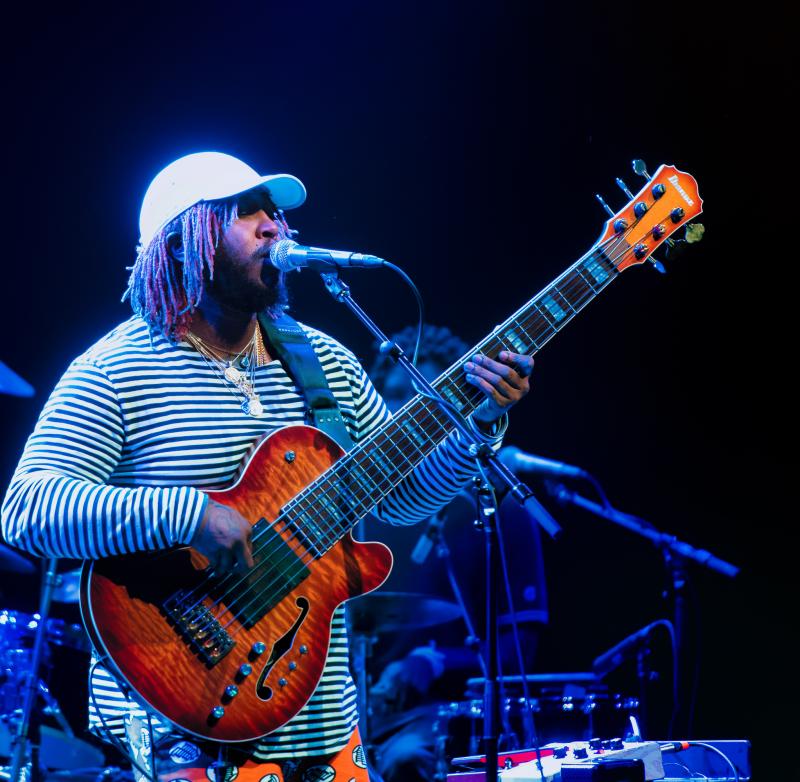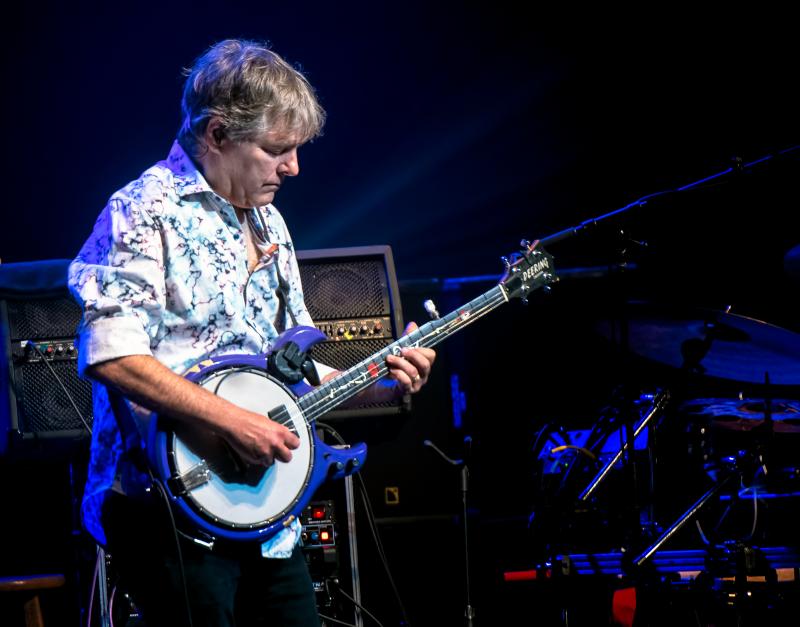Home » Jazz Articles » In Pictures » Headliners and Rising Stars at the 2018 Montreal Interna...
Headliners and Rising Stars at the 2018 Montreal International Jazz Festival
This year marked one of the best and most well-balanced indoor (paid indoor events) and (free) outdoor lineups at the Festival International de Jazz de Montreal (FIJM). The strength of the lineup stretched across genres and also maintained a consistency over the course of the entire festival. There wasn't any day in the 10-day marathon that I could take a break and catch up on some sleep. Since the early days (maybe beginning in year 5 or so), the jazz festival has been positioned as a celebration for the city of Montreal and presents a musical lineup without sharp dividing lines or borders. The goal is to please both jazz aficionados as well as to appeal to music lovers who may prefer other genres. There have always been critics that lamented that fact and even questioned why you would call this a jazz festival when there were so many non-jazz artists. It's not an argument that you can win. You simply have to pick sides. What is indisputable is that every year, the festival offers an abundance of great jazz. I've tried to embrace it all over my many years attending the festival as have most of my peers. We have learned much along the way and have been amply rewarded.
The festival has always featured some of the biggest names in musical entertainment such as Bob Dylan, Sting, Van Morrison, Robert Plant and Tony Bennett. The late great Aretha Franklin was a featured performer on four occasions, and B.B. King had performed nine times. Of course, the festival always highlighted the biggest names in jazz including Miles Davis, Sonny Rollins, Dizzy Gillespie, McCoy Tyner, Oscar Peterson and Keith Jarrett. FIJM has also served as a launchpad or at least a platform for many young (and not quite so young) artists who were beginning to establish themselves like Diana Krall, Renee Rosnes, Christian McBride, James Carter, Melody Gardot and most recently, Cory Henry. Headliners and rising stars are the focus of this third in a series of four In Picture articles on the Montreal Jazz Festival. As I noted in the previous write-ups, John Kelman and Mark Sullivan provided excellent and in-depth reviews, particularly about some of the artists featured in this piece and I reference them periodically. My goal is not to provide comprehensive reviews of these concerts but to convey my experiences through text and images. I also offer some perspective based on my more than 30 years of having attended the festival
There are pictures at the bottom of this page. Feel free to scroll down to view them before continuing on to read the text in its entirety.
I've had the pleasure of seeing Cecile McLorin Salvant on a number of occasions and like others have marveled at her extraordinary voice and complete command of everything she sings. She has grown considerably as an entertainer and knows how to work the audience, at times, using humor, gestures and facial expressions to good effect. Salvant is also a fluent French speaker, and she was very well received by the audience in Montreal. The Christian Sands Trio opened the show. Sands is a brilliant young pianist who demonstrates a mastery well beyond his years. I can only say that I look forward to seeing more of him soon.
My knowledge of Seal stems exclusively from his R&B hits some 25 years ago. I can't say I've kept up. Much to my surprise, he fronted a massive 18-piece jazz orchestra and performed standards and Broadway tunes. He channeled Frank Sinatra, gestures, mannerisms and all, in what was a compelling version of the show tune "Luck be a Lady" (from the Broadway play and later movie, Guys and Dolls). I have seen Bela Fleck and the Flecktones perform several times. Although Fleck was not the first artist to fuse bluegrass with jazz, they were and remain a highly innovative group. It's striking how their music remains so vital after all these years. Herbie Hancock leads a band that is somewhat reminiscent of his groundbreaking 70s fusion band Headhunters, including classics like Actual Proof and Chameleon in their setlists. I saw a version of this band last year at the Monterey Jazz Festival that included Lionel Loueke on guitar and James Genus on bass. As in Monterey, Loueke, was afforded ample space to solo. He ripped off a lengthy, fiercely rocking (perhaps, slightly self-indulgent) solo that enthralled the audience on the very first song. Hancock was enjoying every bit of it and seems to be having just a great time playing with this band. Herbie made a point of offering high praise for Thundercat, who opened the show. He is a brilliant electric bass guitarist and has been compared favorably to greats such as Jaco Pastorius, Marcus Miller, Stanley Clarke and Victor Wooten. I was immensely impressed by his displays of effortless virtuosity. Thundercat can retain melodic content while ferociously shredding on his distinctive (Thundercat Signature) six-string Ibanez bass guitar. His falsetto vocals and compositions less enthralled me, but there is no question that he is a musician to be reckoned with.
Shabaka Hutchings is a brilliant (relatively) young British saxophonist and clarinetist who leads several musical outfits. Last year, Shabaka and the Ancestors gave a superb performance that was easily one of the highlights of the 2017 festival. The Ancestors are comprised of South African musicians that play a sort of free jazz reminiscent of Johnny Dyani or Chris McGregor's Brotherhood of Breath as well as Sun Ra. This year Hutchings returned to Montreal with Sons of Kemet, a four-piece unit including a tuba player, Theon Cross and two drummers, Tom Skinner and Eddie Hick. I listened to their most recent album, Your Queen is a Reptile and frankly did not find it musically interesting. I elected not to pick up a ticket and attended just to take pictures for 10 or so minutes. A few minutes in, it was clear that I had made a big mistake. Cross, a great musician in his own right, and Hutchings are a formidable front line and perhaps, unlike any other tandem that I've heard. An interesting reference point is the twin-tuba fueled lineup of Henry Threadgill's groundbreaking Very Very Circus group. The Sons of Kemet creates a thunderous groove drawing on a range of Afro-Caribbean and other rhythms. Hutchings is emerging as a creative force in the world of jazz, and I will add him to my not-to-be-missed list.
The discovery of new music is one of the best parts of the festival experience. Sometimes the acts are newcomers to the scene, and other times, they are journeymen or veterans of music wars that have just not been on my radar. I've been hearing about the legendary jazz-rock/prog rock pioneers, Soft Machine for decades, but somehow never got around to listening to their music. In his excellent review, Mark Sullivan provides an overview of the history of the group which dates back some 50 years. Although the current lineup doesn't include any of the original members, three out of four musicians first played with the group more than 40 years ago. This isn't your Jersey Shore bar scene (or Las Vegas, if you prefer) version of that band. They are fully credentialed members and can legitimately call themselves the Soft Machine. They sounded just great, and I have begun to explore their extensive back catalog, starting with their acknowledged classic, Third. Fortunately, I have much to explore.
M. Ward is a veteran indie-folk rocker. He is perhaps, best known as a member of folk-rock "supergroup," Monsters of Folk (yes, that is what they are actually called). He is also part of the duo, She & Him with Zooey Deschanel. They are better than you think. I have to say that my knowledge of Ward's solo work is pretty thin, but I came away rather impressed. Ward performed on the Rio Tinto outdoor stage in front of a large and (mostly) appreciative audience. His music touches on a lot of reference points including, country, rockabilly, surf guitar and the blues. He's a very fine guitarist and animated performer. Ward has a soft voice and a laconic delivery. I have to think that this music would work even better in a more intimate setting. Ward fronted a quartet of like-minded musicians, drawing on music that (I believe) spanned his career. The alternatively humorous and melancholy folk ballad, Chinese Translation (from the 2006 album, Post War), evoked an energetic, enthusiastic response from a small group of young people standing near me. I have heard for many years that M. Ward is a talent deserving wider recognition and I have to say that I am in agreement.
No jazz artist has received more mainstream media attention in recent years than tenor saxophonist Kamasi Washington. He has been hailed as a savior of jazz, and that was even before he released his second album. Although he bears little blame for the excessive hype, Washington has become something of a polarizing figure in the jazz community. I am among those who believe his sprawling debut album, The Epic was just brilliant and one of the best releases in recent years. Epic is a three CD/three hour recording which features a killer band of young LA musicians. The music is mostly grounded in the jazz sounds of the early 70s including soul jazz and early funk-fusion. However, some of it is straight ahead hard bop with stretches of some pretty out-there spiritual free jazz reminiscent of Pharoah Sanders and Archie Shepp. Washington is a superb saxophonist deeply into Coltrane. The recording also includes a choir and an orchestra and that contributes to some tedious overkill at points. But a lot of the music is just superb and stands up to multiple listens. His recently released album, Heaven and Earth continues in a similar vein, but rounds the corners and smooths out the rough edges of Epic and thus builds on its crossover appeal. Although the new album has garnered considerable acclaim, it is less to my liking. Washington performed before a full house at MTelus, a sizeable cavernous venue that accommodates around 2300 people. Washington is a fine performer and he accentuated the crowd-pleasing elements of his music while diminishing the more challenging aspects. That said, Kamasi fronts an excellent live band. Ryan Porter on trombone and Washington on tenor constitute an excellent front line. They are more than ably supported by a rhythm section of Ronald Bruner Jr. on drums and Miles Mosley on bass. Patrice Quinn is an excellent vocalist and a most engaging performer. The group performed a generous 2-hour set and was received enthusiastically by the rather youthful audience.
Brian Blade and the Fellowship Band were one of the most eagerly anticipated shows at the jazz fest. Blade is among the most in demand drummers in jazz. This was Blade's 21st appearance at the fest with his first being in 1995. He is a regular member of the much celebrated Wayne Shorter Quartet. Blade has also appeared as a sideman or co-leader with Chick Corea, Joshua Redman, and Bill Frisell, to name just a few. Last year's appearance with the Still Dreaming band, also featuring Joshua Redman, was nothing short of brilliant. One of the great highlights of the 2017 festival. This was the third appearance of the Fellowship Band, the first being in 1998. Both John Kelman and Mark Sullivan reviewed this concert. Kelman provides a detailed over overview of the band's history including the changes in personnel over the course of their 20 year history. The Fellowship has always been a collective in which the songs are privileged over individual displays of musicianship. Much of the music is through-composed, but there was still more than enough room for some sparkling solos, most notably by alto saxophonist Myron Walden and pianist John Cowherd. The music consists of beautiful folk jazz melodies played mostly at mid-tempo (or slower). The music is played with great depth of feeling and has a certain spiritual quality to it that is very moving. At the end of the 100 minute set, the audience gave the group an extended and thunderous standing ovation. This was easily one of the highlights of this year's festival.
Maison Symphonique is a magnificent hall, completed in 2011, principally used by the Montreal Symphony Orchestra. It's a beautiful space with pristine acoustics that can seat up to 1900 patrons. I attended just one concert at the venue, but it was an exceptional one. Zakir Hussain, Dave Holland and Chris Potter are among the finest musicians on the planet. Hussain was accorded the honor of the Antonio Carlos Jobim award for his exemplary contribution to world music and its impact on jazz. Holland and Hussain have attained legendary status over the course of their nearly five-decade respective careers. I can't remember a time when I didn't think that Chris Potter was a great saxophonist, but his playing has improved immeasurably over time. The trio had played together as part of Hussain's Crosscurrent project which is a seven-piece outfit that plays a kind of Indo-Jazz fusion. Of course, Potter was part of Dave Holland's outstanding quintet for several years. I had the pleasure of seeing the same trio play at the Musical Instrument Museum (MIM) about three weeks earlier on their second night of the tour. The MIM in Phoenix is a more intimate concert hall, seating just 300 people, that also offers outstanding acoustics. Although I much enjoyed both performances, the Montreal show reflected the fact that the trio had been working together for several weeks and sounded more cohesive as a unit. Unlike the larger Crosscurrents group, this is very much a jazz trio, albeit a musically expansive one, drawing on compositions from each of the three participants. Having listened to jazz trios, it's also a bit of a mental adjustment to hearing a tabla when your brain expects to be hearing a drummer. Hussain is a brilliant virtuoso and plays a range of differently pitched tablas and other percussion devices. In Phoenix, Holland and Hussain engaged in a series of magnificent duets. Although they had played together before, Hussain would throw curveballs which seemed to surprise and amuse Holland continually. Holland would respond in kind. They were obviously enjoying themselves. I also noted in both Montreal and Phoenix how much Holland relished the opportunity to take extended solos—something typically less available to him in the larger group settings like his quintets. I don't think it's a stretch to say that Holland is one of the most justifiably celebrated soloists on the double bass in jazz history. Chris Potter is an endlessly inventive and powerful soloist in his own right, and his powers were on full display. The Montreal show demonstrated that Trio had developed greater music chemistry, nuanced interplay and shared humor. They were obviously having a great time.
The excellent Renee Rosnes group was the opening act in effect which was a double bill. Before the performance, Rosnes was awarded the 2018 Oscar Peterson award in recognition of her significant contribution to Canadian jazz. Rosnes has enjoyed an impressive career that includes numerous recordings on the Blue Note label and other fine dates as a leader and as a side musician. Recently, she released an album, Beloved of the Sky, on Smoke Session Records and this most certainly ranks with her best work. It is also one of the best new releases of 2018. Sullivan provided a detailed review. I wanted to note that this is an excellent quartet of outstanding musicians. I particularly enjoyed the work of Steve Nelson on vibes. He can serve as a first-rate colorist juxtaposed against Rosnes piano, contributing much to the group's distinctive sound. Nelson can also swing fiercely as the situation warrants. Chris Potter is a featured guest on the album and makes an outstanding contribution. I was half anticipating/hoping that he would sit in with the quartet. Although that did not happen, the group was just exceptional.
The musical duo of Emile Parisien (soprano sax) & Vincent Peirani (accordion) opened up for the Steve Kuhn Trio. I had not previously heard of either musician and was suffering a little from opening act fatigue on day nine of the festival. To complicate matters, I was accompanied by my 17-year-old nephew who is a hard-core gamer, not particularly a jazz fan and well, he has the attention span of most teenagers. Initially, I was hoping for a mercifully short set. But the duo was just outstanding and we both enjoyed their performance. The virtuoso musicians draw on various strands of the French jazz tradition(s) from Gypsy jazz to the romantic strains of (the great accordionist) Richard Galliano to the more avant-garde sounds of (saxophonist and clarinetist) Michel Portal. They play with both a seriousness of purpose and much humor.
I don't think Steve Kuhn would quite qualify as a headliner. At age 80 and some 60 years into a stellar career as both a sideman and leader, he is probably not a rising newcomer either. Kuhn is a distinguished pianist and composer who is still at the peak of his powers as he enters his 9th decade. This marked his 11th appearance at the Montreal Jazz Festival, first being in 1984. I saw him most recently in 2013, accompanied by Steve Swallow and Joey Baron on drums. That was a genuinely outstanding concert. Although this year's performance did not quite rise to that standard, it was most enjoyable. Kuhn played music from a vast repertoire including standards and originals. He was ably accompanied by Aidan O'Donnell on bass and Billy Drummond on drums. I was positioned behind Drummond's kit for a time and marveled at both his sensitive touch and his driving intensity. Drummond has been a member of (some of) Kuhn's piano trios dating back more than 20 years. Kuhn continues to record regularly and his 2009 recording which features Joe Lovano in addition to the trio, Mostly Coltrane is a personal favorite. At the 2013 concert, Kuhn performed Acknowledgement, the first part of the A Love Supreme suite. In Acknowledgement, Trane repeats the chant "A Love Supreme," whereas Kuhn inserted the phrase "I Love the Supremes." It was a surprisingly humorous moment in an otherwise reverential treatment of the venerable piece. Kuhn may not be a rising newcomer, but at age 80, he remains a talent deserving wider recognition.
Every year, there is a blockbuster event to close out the festival. The event is held on Place de Festival, which is a very long and wide city block that is repurposed for large festival events (see the crowd photo). The crowds for these events, including this one, often number in excess of 100,000 people. They have continually modified the space, adding grandstands, sponsors and press tents, food and beverage stands, and a couple of restaurants along the sides. They have impressive lighting effects (sometimes overkill) and surprisingly good sound. There are also video screens distributed throughout to support viewing by fans further back from the stage. The stage is elevated by about 10 feet above street level. There is a photographers pit with an elevated platform to enable them to take pictures. There are typically 5 or 6 photographers present for a given concert. On this occasions, there were maybe 30 to 40 in the enclosed space. Although things remain reasonably civilized, we were all jockeying for positions. The featured act was the indie-rock band, The War on Drugs. They are a band on the rise and was awarded a Grammy for Best Rock album for their recent album, A Deeper Understanding. I have been a fan since their excellent 2014 recording, Lost in a Dream. The six-piece band is known for their fine songcraft and on record, the compositions are privileged overs displays of musicianship. They also happen to be an excellent live band. The group is led by singer-songwriter and lead guitarist, Adam Granduciel. Their sound can be characterized as a blend of 80s/90s indie guitar sound coupled with synth/keyboards and the occasional use of horns. On stage, Granduciel is the dominant force and his guitar, the primary instrumental voice. He unleashed several blistering guitar solos that suggest a guitar prowess not readily apparent on record. The one thing War on Drugs is not is a party band and perhaps, not the best choice for this kind of event. They are not likely to exhort the audience to get up and dance or to engage in some soul-clapping or even to sing-along. Their music offers the potential for an immersive experience, rewards careful listening and knowledge of the songs. This was undoubtedly lost on some of the audience. On the other hand, many of us thoroughly enjoyed their live performance and others soaked in the festive experience.
< Previous
Transcendence
Next >
Live at Big Apple in Kobe
Comments
Tags
In Pictures
Dave Kaufman
Canada
Montreal
Bob Dylan
Sting
Van Morrison
Robert Plant
Tony Bennett
Aretha Franklin
B.B. King
Miles Davis
Sonny Rollins
Dizzy Gillespie
McCoy Tyner
oscar peterson
Keith Jarrett
Diana Krall
Renee Rosnes
Christian McBride
James Carter
Melody Gardot
Cory Henry
John Kelman
Mark Sullivan
Cecile McLorin Salvant
Christian Sands
Seal
frank sinatra
Bela Fleck and the Flecktones
Herbie Hancock
Headhunters
Monterey Jazz Festival
Lionel Loueke
James Genus
Thundercat
Jaco Pastorius
Marcus Miller
Stanley Clarke
Victor Wooten
shabaka hutchings
Johnny Dyani
Chris McGregor
Brotherhood of Breath
Sun Ra
Sons of Kemet
Theon Cross
Tom Skinner
Eddie Hick
Henry Threadgill
Very Very Circus
Soft Machine
kamasi washington
Pharoah Sanders
archie shepp
Ryan Porter
Ronald Bruner Jr.
miles mosley
Patrice Quinn
Brian Blade
Fellowship Band
Joshua Redman
Bill Frisell
Myron Walden
John Cowherd
Zakir Hussain
Dave Holland
Chris Potter
jny= Phoenix
Steve Nelson
Emile Parisien
Steve Kuhn
Richard Galliano
Michel Portal
Aidan O'Donnell
Billy Drummond
joe lovano
For the Love of Jazz
 All About Jazz has been a pillar of jazz since 1995, championing it as an art form and, more importantly, supporting the musicians who create it. Our enduring commitment has made "AAJ" one of the most culturally important websites of its kind, read by hundreds of thousands of fans, musicians and industry figures every month.
All About Jazz has been a pillar of jazz since 1995, championing it as an art form and, more importantly, supporting the musicians who create it. Our enduring commitment has made "AAJ" one of the most culturally important websites of its kind, read by hundreds of thousands of fans, musicians and industry figures every month.

